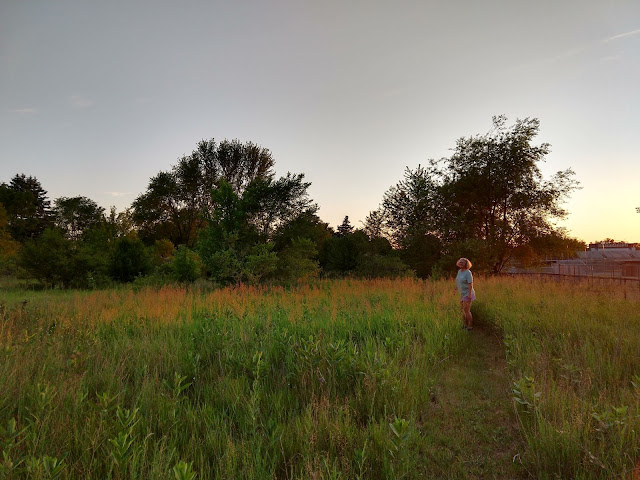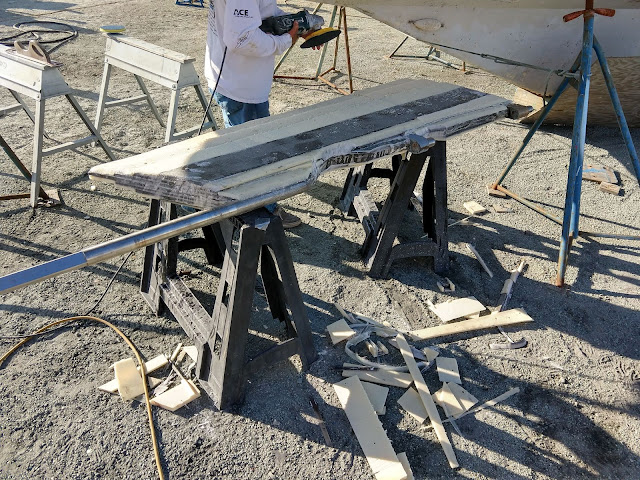Back in February I broke my rudder, but still was able to fix it well enough to sail back to FL, where I figured repairs would be far easier. Once in the boat yard, we were told that repairing the rudder would be far easier and cheaper than building a new one and that they would guarantee the result, unlike what I'd get if I built myself a new one, so I reluctantly gave the go ahead.
Of course, I couldn't let go entirely of the chance to play around with designing and building a new rudder, so I did the research and the math, bought some cheap plywood, and tried to make a rudder mock-up... and really liked it!
Still.... they were already working on the repair and who am I to ignore the experts?
Once the rudder subcontractor opened the rudder, they discovered that it had been repaired at least twice in the past and, in one of those repairs, the rudder post was actually bent... or had perhaps been bent from the beginning. The interior of the rudder also had what seemed like a lightweight foam rather than the very dense and strong foam that is standard and the rudder post was secured in the rudder with this and some lumps and chunks of fiberglass. Lousy repairs.
I also had the main contractor look at the leaking around the rudder port (the fitting the rudder post passes through to go into the boat and prevent water from entering) and he said it had been severely and poorly modified by some prior boat yard, so we decided to replace that as well.
Then along came Covid-19. I decided to visit my folks in CA before things got bad enough for travel to shut down and while the yard was working on the rudder, but travel shut down once I was there, the yard shut down in FL (but continued to charge large amounts), and, although the rudder post and port arrived, the rudder repairs seemed to drag on with no communication.
FINALLY, the rudder subcontractor sent me a text showing the rudder installed!
Hooray! I flew to Cynthia in MI and the two of us drove (with Lucy) to FL.... where we tested the rudder and found it would not turn. The rudder sub had repaired it WRONG, possibly installing the nice new straight rudder post in the slot that worked for the bent rudder post. AND, while the typical repair charge is for about 30 hours, he wanted over 90 hours!
After a few days of grinding teeth and listening to various people come up with WRONG diagnoses and solutions, I finally told the main contractor to reinstall the rudder port to my alignment (He had installed it to the rudder...which was wrong. I used a long shaft to align it correctly.)
and told him that would absolve him of further responsibility. That made me happy... but I still needed to deal with my main nemesis, the rudder.
I showed the rudder fellow that the port was now aligned and told him this meant the rudder was the only problem. He disagreed and fiddled with it for a couple hours....
while I sat and watched and literally ground my teeth. Finally I called him over and told him, in a calm voice, that I was furious about the whole thing, furious that he had promised three times that the repair was well within his ability to get right. I told him I really wanted someone else to fix the problem. He told me that he still did not think it was the rudder, but I could certainly have someone else work on it and, if I could make things work without changing the alignment of rudder port and shoe (top and bottom fittings), I would not owe him a penny. I shook his hand and told him that I thought that was a fair and honorable plan and we parted amicably.
Relief pouring off me, I pulled out my instruments of destruction and went to work on opening the rudder to extract the hardware: rudder post and bottom pintle. The main contractor lent me various tools that made things far easier than my familiar sawzall and in a couple hours I had opened the rudder (finding quite a poor repair inside),
released the post, and reinstalled the post in some more epoxy to prove the rudder post alignment was our only problem. The next morning the rudder turned beautifully, proving my point. Now... how about that new rudder?
Most rudders are built on a core of foam and covered with fiberglass, just like a surfboard. I wanted something more sturdy and something I could easily create in the boat yard, so followed my earlier thoughts about creating it out of a board called Coosa, a foam-cored fiberglass sandwich. I had found the price would be rather high, about $800 for the two sheets, but worth it. Then my friend John, the main contractor, said he could get me two boards for about $300 total! Very nice!
Cynthia and I laminated the Coosa with layers of epoxy and fiberglass, adding a foam edge in the areas I would grind to shape the rudder curve. Screws held everything together while the glue cured. We first created the center layers and a reinforced area for the bottom pintle, then cut out a recess to fit the rudder post, embedding the rudder post in thickened epoxy and installing the rudder to ensure alignment.
Once the rudder post glue had cured, we installed the encapsulating third core layer with more epoxy and glass, then created the reinforced area for the center pintle
and installed it with bronze bolts. We then installed the final two layers of Coosa, glass, and foam on each side of the rudder....
Once this set, we went at it with the sawzall, trimming off excess. Then our friend Tony took up the grinder and shaped the rudder roughly,
then the three of us faired the rudder with thickened vinyl ester resin and installed a layer of glass mat, saturated with more vinyl ester resin.
The next morning, I brought out the sawzall to trim and Tony suited up and brought out his grinder, then the three of us installed three layers of 1708 fiberglass on each face, Cynthia and I assisting and learning while Tony impressed us with his rapid application of large amounts of glass. Then.... we again waited for the glass to harden completely by the next morning.
Once again: sawzall and grinder.
Then some more fairing and sanding.
Finally, primer and paint.
Now, to my delight:
the rudder can be removed without needing to bend fittings;
the rudder sits farther back from the keel, so we can paint and clean things better;
the rudder sits farther back, so we do not need such a large scoop out of it
for the propeller to be removed and installed;
the rudder sits farther back, so the same size rudder has a little more steering power;
the rudder has an airfoil shape rather than being a lumpy thick board;
AND I've had a lot of fun learning and working with Cynthia and friends... and I've saved some money.





















































